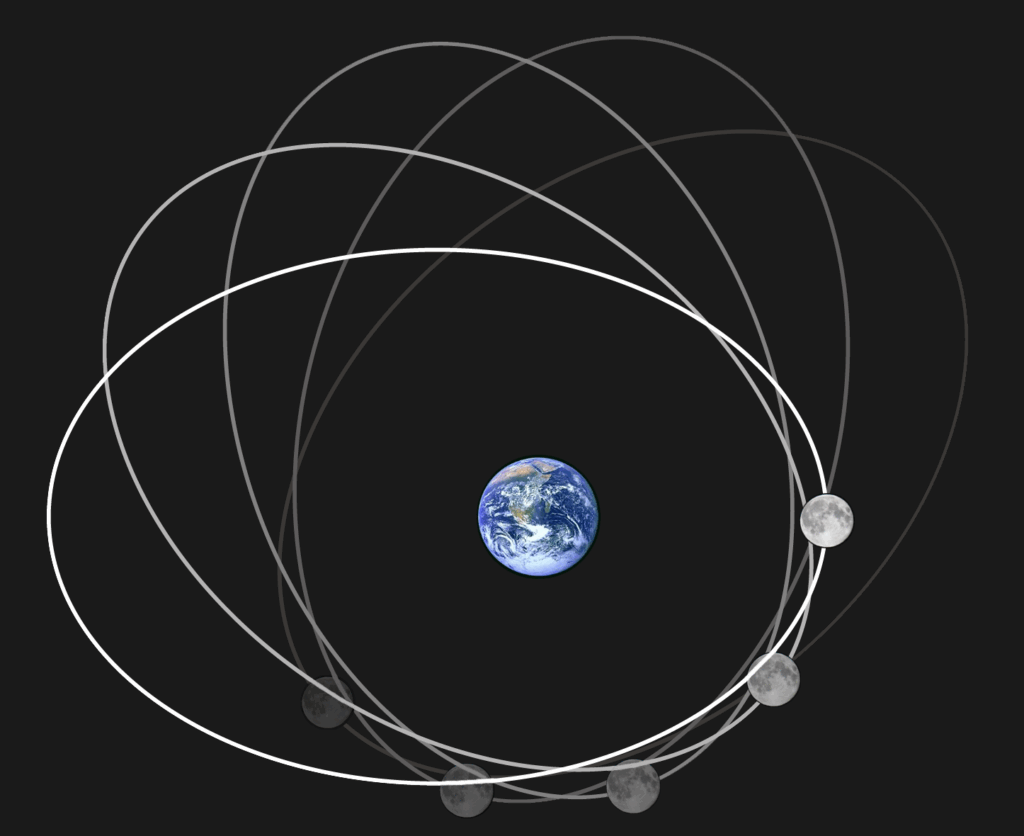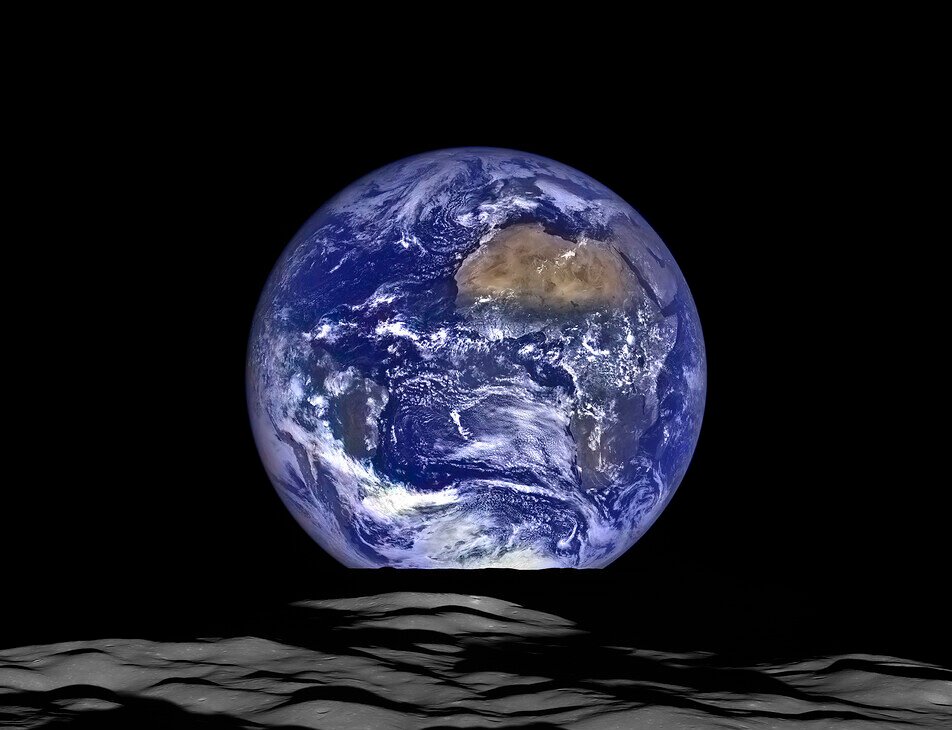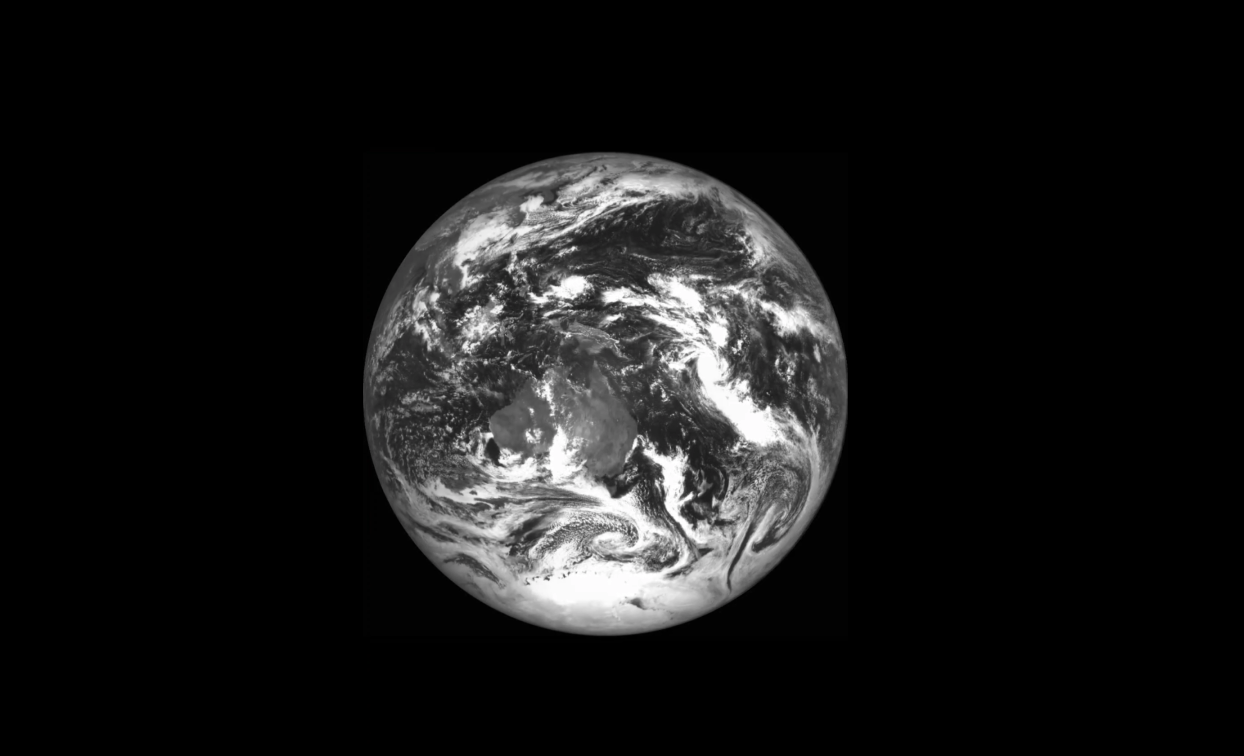Look up at the Moon tonight and you’re seeing more than just a beautiful celestial body. You’re gazing at Earth’s cosmic bodyguard, a silent protector that’s been keeping our planet stable for over 4 billion years. Without this ancient companion, our world would be a chaotic, unrecognizable place where life as we know it could never have taken hold.
The Moon as Earth’s Gyroscopic Stabilizer

The moon has long been recognized as a significant stabilizer of Earth’s orbital axis. Without it, astronomers have predicted that Earth’s tilt could vary as much as 85 degrees. Think of Earth like a spinning top. When a top spins perfectly upright, it stays balanced, but as it slows down, it starts to wobble more and more until it eventually falls over. In the case of the Earth: the presence of the Moon induces a relatively fast rate of precession: 50.47 seconds per year. Since the Earth rate of precession is significantly faster than most of the periodic changes in Earth orbit the probability of a significant resonance is low. The Moon acts like a steady hand, keeping Earth from wobbling too wildly. Without our lunar companion, our planet’s 23.5-degree tilt could swing dramatically between almost upright and nearly sideways over time periods measured in millions of years. In such a scenario, the sun would swing from being directly over the equator to directly over the poles over the course of geological time.
How Tidal Forces Create Stability

The stabilization comes from the tidal interaction between the Earth and the Moon. The same tidal interaction that makes high and low tides line up closely with the Moon, does the same thing with the bulge at our Equator; in effect the bulge is like a big high tide that tends to favor facing the biggest tidal force — which is from the Moon. The moon speeds up the precession of the earth’s axial tilt, giving it sort of a second-order angular momentum about that precession axis. This is caused by the moon tugging on the equatorial bulge of the earth, attempting to bring the bulge in line with the moon’s orbital plane. It’s like having a friend spot you while you’re carrying a heavy, awkward load—they don’t carry the weight for you, but they help keep you from stumbling. The Moon’s gravitational pull on Earth’s equatorial bulge creates this stabilizing effect, preventing our planet from tilting too far in any direction.
Mars: A Cautionary Tale Without a Large Moon

From the above reference: “Indeed, Laskar and Robutel also showed that the axial tilt of Mars, which has only two tiny moons, has varied between 10° and 60° in the past, which caused huge climate variations that in turn could have contributed to the loss of most of the planet’s atmosphere, leaving Mars the bone-dry desert world that it is now. Mars’ two satellites, Phobos and Deimos, are tiny, captured asteroids that have little known effect on the Red Planet. Consequently, Mars’ tilt wobbles chaotically over timescales of millions of years, with evidence for swings in its rotational axis at least as large as 45 degrees. Picture trying to maintain your balance while walking on a tightrope with your arms constantly flailing—that’s essentially what Mars experiences without a large stabilizing moon. This wild tilting has contributed to Mars losing much of its atmosphere and water over billions of years. What was once potentially a more Earth-like world became the barren, frozen desert we see today.
The Moon’s Formation: A Violent Birth with Stabilizing Consequences

The hypothesis suggests that the Early Earth collided with a Mars-sized protoplanet of the same orbit approximately 4.5 billion years ago in the early Hadean eon (about 20 to 100 million years after the Solar System coalesced), and the ejecta of the impact event later accreted to form the Moon. The impactor planet is sometimes called Theia, named after the mythical Greek Titan who was the mother of Selene, the goddess of the Moon. This collision was so massive that it melted both Earth and the impactor, flinging debris into space that eventually coalesced into our Moon. It grew larger thanks to countless collisions between dust particles, asteroids, and other growing planets, including one last giant impact that threw enough rock, gas, and dust into space to form the moon. Ironically, this violent birth created the very stabilizing force that would later make Earth a haven for life. On Earth, we know that the impact with Theia and other changes throughout its history are part of how it was able to gather the materials necessary for life.
What Earth Would Look Like Without the Moon’s Stabilizing Force

Without the Moon to stabilize our earth the wobble and angular tilt would be erradic, and would result in extreme seasons, weather and incredible high and low tides. Imagine a world where the Arctic could become tropical and the equator could freeze solid over the course of millions of years. Without the moon, Earth’s tilt might be more unstable, leading to extreme variations in climate over long periods. The polar ice caps would advance and retreat dramatically, ocean currents would shift chaotically, and weather patterns would be completely unpredictable over geological timescales. Without the moon, the Earth would wobble violently. These shifts in the angle of tilt of the Earth would lead to rapid changes in the Earth’s climate. Some regions would experience perpetual winter while others might endure scorching summers that last for thousands of years.
The Debate: How Critical Is the Moon Really?

That’s because really big changes in a planet’s tilt would occur only after a very long time, so there would be more than enough time for the evolution of life, Lissauer reported yesterday here at the summer meeting of the American Astronomical Society. “The variations in Earth’s axial tilt would indeed be substantially larger if there was no large moon,” Lissauer says, “but really big excursions from the current value would only occur on time scales of billions of years.” Some scientists argue that while the Moon certainly helps stabilize Earth, the changes without it might happen so slowly that life could adapt. Lissauer’s team found that without the Moon, Earth’s rotational axis would only wobble by 10 degrees more than its present day angle of 23.5 degrees. However, others maintain that the cumulative effects over millions of years could still be devastating for complex life forms. I don’t think [changes in a planet’s axial tilt] would be a problem for the development of advanced life,” as any type of life would adapt to changing circumstances anyway, says planetary scientist Sara Seager of the Massachusetts Institute of Technology in Cambridge.
The Moon is Slowly Drifting Away from Earth

Laser ranging measurements of the change in the distance from the Earth to the Moon tell us that the Moon is moving away from the Earth at a rate of about 3.78 cm per year. Ancient astronomical footsteps tell us that our moon has been slowly retreating from Earth’s orbit for a staggering 2.5 billion years. It’s an imperceptibly slow journey, of course, with the moon creeping approximately 3.8 cm away from us each year. This might seem like an incredibly small distance—about the width of your thumb nail—but over millions of years, it adds up. The paper recently published in the Proceedings of the National Academy of Sciences, shows that about 2.46 billion years ago, the Moon was about 60,000 kilometers closer to Earth than it is now. This means our days were shorter then, just around 17 hours instead of the 24 hours we’ve come to expect. Back then, the Moon appeared three times larger in the sky than it does today, and Earth spun much faster, giving us those shorter days.
Why the Moon is Moving Away: The Physics Behind the Drift

It’s driven by the effect of the Moon’s gravity on the rotating Earth. Tides raised in the oceans cause drag and thus slow the Earth’s spin-rate. The resulting loss of angular momentum is compensated for by the Moon speeding up, and thus moving further away. Think of it like a figure skater who starts spinning with their arms close to their body and then extends them outward—they slow down as their arms move away from their center. Gravitational coupling between the Moon and the tidal bulge nearest the Moon acts as a torque on the Earth’s rotation, draining angular momentum and rotational kinetic energy from the Earth’s spin. In turn, angular momentum is added to the Moon’s orbit, accelerating it, which lifts the Moon into a higher orbit with a longer period. As Earth’s rotation slows due to tidal friction, that energy has to go somewhere—and it goes into pushing the Moon into a higher, more distant orbit. Since the Earth and the moon are part of the same gravitationally interacting system, total angular momentum must be conserved — stay the same — between the two,” Broome explained. “Angular momentum describes the energy contained by something that is spinning.
Longer Days and Weaker Tides in Our Future

This subtle separation has significant implications for both bodies. Over time, the increasing distance alters Earth’s day length and the Moon’s orbit, leading to longer days and a larger orbit for the Moon as the effects of this gravitational relationship become evident. As the Moon continues its slow retreat, our days will gradually become longer and the tides will become weaker. In about 50 billion years, Earth’s slowing rotation would make it tidally lock with the moon so that Earth would permanently show just one side to the moon, Jean Creighton, director of the Manfred Olson Planetarium at the University of Wisconsin-Milwaukee, told Live Science. Eventually, if nothing else intervened, Earth would show the same face to the Moon all the time, just like the Moon currently shows the same face to Earth. One side of our planet would experience perpetual day while the other would be locked in eternal night. However, this scenario is purely theoretical since other cosmic events will intervene long before this happens.
The End of Total Solar Eclipses

First, say goodbye to the total solar eclipse. “Over time, the number and frequency of total solar eclipses will decrease,” lunar scientist at NASA’s Goddard Space Flight Center Richard Vondrak said in 2017. “About 600 million years from now, Earth will experience the beauty and drama of a total solar eclipse for the last time.” The Sun and the Moon look about the same size in the sky as the Sun is about 400 times further away from the Earth than the Moon, and about 400 times bigger in diameter. Four billion years ago, before the Moon drifted to its current orbit, it would have appeared about three times as big as it is now in the sky. Right now, we live in a special cosmic moment where the Moon appears almost exactly the same size as the Sun in our sky, creating those spectacular total solar eclipses that have inspired humans for millennia. As the Moon continues to drift away, it will appear smaller and smaller, until eventually it will be too small to completely block out the Sun.
Will the Moon Eventually Escape Earth’s Gravity?

Calculations of the evolution of the Earth/Moon system tell us that with this rate of separation that in about 15 billion years the Moon will stop moving away from the Earth. Now, our Sun is expected to enter its Red Giant phase in about 6 to 7 billion years. So, the answer to your first question is that the Sun will engulf the inner planets as its outer layers expand during its Red Giant phase before the Moon will stop moving away from the Earth. While the Moon will continue to drift, appearing smaller and smaller in the sky, it will never be free of our orbit. The Sun will become a red giant and engulf the Earth before we are properly separated from the Moon’s influence. We shall go down together. The Moon won’t abandon us—instead, our cosmic partnership will end when the Sun exhausts its nuclear fuel and swells into a red giant star, potentially swallowing both Earth and the Moon in its expanded outer layers.
Implications for Life on Earth Throughout History

In 1993, French mathematicians Jacques Laskar and Philippe Robutel showed that Earth’s large moon has a stabilizing effect on our planet’s climate. Without the moon, gravitational perturbations from other planets, notably nearby Venus and massive Jupiter, would greatly disturb Earth’s axial tilt, with vast consequences for the planet’s climate. The Moon’s stabilizing influence has been crucial for the development of complex life on Earth. Laskar argued that should Earth’s obliquity wander over hundreds of thousands of years, it would cause environmental chaos by creating a climate too variable for complex life to develop in relative peace. Over the past 3.8 billion years, as life evolved from simple single-celled organisms to complex multicellular creatures, the Moon has provided the stable platform necessary for this progression. Without this stability, evolution might have taken completely different paths, if it could have produced complex life at all. The consistent seasons and relatively stable climate zones that the Moon helps maintain have allowed ecosystems to develop and thrive over geological timescales.
What Happens to Earth’s Rotation as the Moon Drifts Away

The final stage will be “tidal locking,” in which the Earth’s rotational period is the same as the Moon’s orbital period (one day = one lunar month). At that point, the tidal bulge on Earth will always be directly below the Moon, and there’ll be no torque. This tidal locking has already happened for the Moon: presumably at one point the Moon rotated faster than it does today, but tidal torques on the Moon (just like the tidal torques on the Earth considered here) slowed down its rotation until it kept the same face toward the Earth. As the Moon continues to move away, Earth’s rotation will slow more and more. Days will become progressively longer over millions of years. The process will eventually reach an equilibrium state where both Earth and the Moon show the same face to each other, locked in a cosmic dance where one day equals one month. However, this process takes so incredibly long that other astronomical events will intervene first. The Moon has already achieved this state with Earth—that’s why we always see the same side of the Moon from our planet.
Unique in the Universe: Earth’s Rare Moon

Only ten percent of terrestrial planets may have satellites comparable to Earth’s moon, which means it might be not only unique in the solar system, but throughout the universe as well. So his argument goes, we should feel remarkably lucky to have such a large moon on our doorstep, as no other terrestrial planet in our solar system has such a moon. Our Moon is proportionally much larger compared to Earth than most moons are to their planets. With its relatively substantial mass, the Moon has a mass ratio of 1:81.3 with respect to Earth, which is second only to the Pluto–Charon system in the Solar System. Generally, astronomical observations indicate that the mass ratio between satellites and their planets usually falls below 1:1,000. This makes the Earth-Moon system quite special in our cosmic neighborhood. The formation of such a large moon relative to its planet requires very specific conditions that may be uncommon in the universe. The early solar system was very dynamic and filled with collisions. During this time, a stabilizing, Earth-like moon could form, only to be knocked out of orbit by the next body plowing into the system. “Multiple impacts might…destroy existing satellites,” Elser told SPACE.com in an email interview. In order to become a permanent part of the system, a crashing body would have to be the last major impactor.
The Moon’s Role in Ocean Tides and Marine Life

The Moon’s gravitational pull creates the tides that have shaped life on Earth in profound ways. These tidal forces don’t just move water—they’ve influenced evolution itself. Many marine creatures time their reproduction cycles to the lunar month, and intertidal zones have become unique ecosystems that exist because of the daily rhythm of high and low tides. As the Moon moves away and its gravitational influence weakens, tides will become smaller and less pronounced. The rich biodiversity of tidal pools and coastal ecosystems that depend on these regular cycles may face challenges adapting to weaker tidal forces. The Moon essentially created an ecological niche that has been stable for billions of years, and its gradual retreat will slowly alter these environments over geological time.



